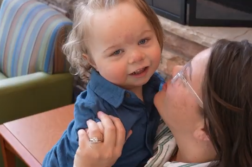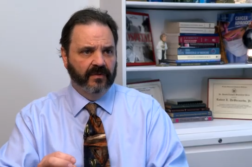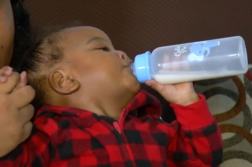DENVER, Colo. (Ivanhoe Newswire)— It’s a never-ending pain, sometimes dull, sometimes sharp, accompanied by stiffness and loss of mobility. Fourteen million people suffer from arthritis in the knee. New numbers show that one out of 12 adults over the age of 25 will have a knee replacement sometime during their lifetime. But one new treatment is hoping to delay a replacement and take the pain away by transplanting fat cells.
Al Perez has been teeing up … And teeing off … For more than half his life. But his game started to suffer.
“Walking became difficult because I get some swelling and pain,” Perez explained.
Al had his right knee replaced eight years ago and he didn’t want a repeat procedure on his left.
“I have some arthritis in that knee, osteoarthritis, and I wanted to avoid at all costs another knee replacement,” shared Perez.
He found orthopedic surgeon Jason Dragoo at the Steadman Hawkins Clinic. Dragoo was part of a team that made stem-cell history.
“It set off this revolution worldwide of getting stem cells from fat,” Jason Dragoo, MD an orthopedic surgeon at UCHealth, Denver.
And now, he’s using those stem cells to ease his patients’ knee pain.
“Mother Nature put in this piece of fat that’s in our knee, it’s called the fat pad. And we looked at the fat pad and it contains a very high number of stem cells,” illustrated Dr. Dragoo.
During surgery, Dr. Dragoo harvests the stem cells from the fat pad.
“We process them in the operating room and then give them back to patients during the same surgical procedures,” elaborated Dr. Dragoo.
The best candidate is someone with moderate to middle-stage arthritis. Initial studies show that the treatment reduces pain and inflammation. Now, they are looking to see if the cartilage regrows. It worked for Al. He’s four years post-surgery and his pain is gone.
“Within three, four days I was walking with barely a limp. I was good. I can walk 18 holes.”
From harvesting the cells to implant, the procedure takes about 20 minutes. Right now, the treatment is being performed at the Steadman Hawkins Clinic in denver, as well as Cedars-Sinai and The Ohio State University.
Contributors to this news report include: Cyndy McGrath, Executive Producer; Marsha Lewis, Field Producer; Rusty Reed, Videographer; Roque Correa, Editor.
To receive a free weekly e-mail on Medical Breakthroughs from Ivanhoe, sign up at: http://www.ivanhoe.com/ftk
MEDICAL BREAKTHROUGHS
RESEARCH SUMMARY
TOPIC: TRANSPLANTING FAT CELLS: RELIEVING KNEE PAIN
REPORT: MB #4798
KNEE PAIN: Knee pain is a common complaint that affects people of all ages. It may be the result of an injury, such as a ruptured ligament or torn cartilage. Medical conditions including arthritis, gout and infections can also cause knee pain. Minor knee pain responds well to self-care measures. Physical therapy and knee braces also can help relieve knee pain. In some cases, however, your knee may require surgical repair. Signs and symptoms that sometimes accompany knee pain include swelling and stiffness, redness and warmth to the touch, weakness, instability, popping or crunching noises and inability to fully straighten the knee. Not all knee pain is serious. But some knee injuries and medical conditions, such as osteoarthritis, can lead to increasing pain, joint damage and disability if left untreated. And having a knee injury makes it more likely that you’ll have similar injuries in the future.
(Source: https://www.mayoclinic.org/diseases-conditions/knee-pain/symptoms-causes/syc-20350849)
CAUSES AND DIAGNOSING KNEE PAIN: Some of the more common knee injuries include a torn ACL which is a tear of the anterior cruciate ligament (ACL), fracture to the kneecap, torn meniscus, knee bursitis, and patellar tendinitis. Mechanical problems can also cause knee pain including degeneration of bone or cartilage which can cause a piece of bone or cartilage to break off and float in the joint space, Iliotibial band syndrome which occurs when the tough band of tissue that extends from the outside of your hip to the outside of your knee (iliotibial band) becomes so tight that it rubs against the outer portion of your femur, dislocated kneecap, hip or foot pain and arthritis.
(Source: https://www.mayoclinic.org/diseases-conditions/knee-pain/symptoms-causes/syc-20350849)
STEM CELL TECHNOLOGY IN TREATING KNEE PAIN: In 2006 Dr. Jason Dragoo, Professor and Vice Chair in the Department of Orthopedic Surgery at the University of Colorado was with a group of scientists at UCLA and the University of Pittsburgh when they jointly discovered that there were stem cells within fat tissue. The researchers thought maybe stem cells reside in the knee and there is fat in the knee called the fat pad. So, they devised a way to harvest a portion of the fat pad and the cells within it during normal arthroscopic surgery. Then they process the cells in the operating room and give them back to the patient during the same surgical procedure. Studies have shown that stem cells release factors that reside on opioid receptors. Those are one of the pain-relieving receptors that we have in our body and that is the reason that stem cell therapy is thought to decrease pain.
(Source: Interview with Dr. Jason Dragoo)
FOR MORE INFORMATION ON THIS REPORT and Transplanting Fat Cells, PLEASE CONTACT:
CHRISTINE LEVINE
608-239-1687
If this story or any other Ivanhoe story has impacted your life or prompted you or someone you know to seek or change treatments, please let us know by contacting Marjorie Bekaert Thomas at mthomas@ivanhoe.com




